BRASS CYLINDER POCKET MICROSCOPE WITH MIRROR BASE:
'THE MICROSCOPE'
c. 1st HALF 20TH C.
? FRENCH
DESCRIPTION: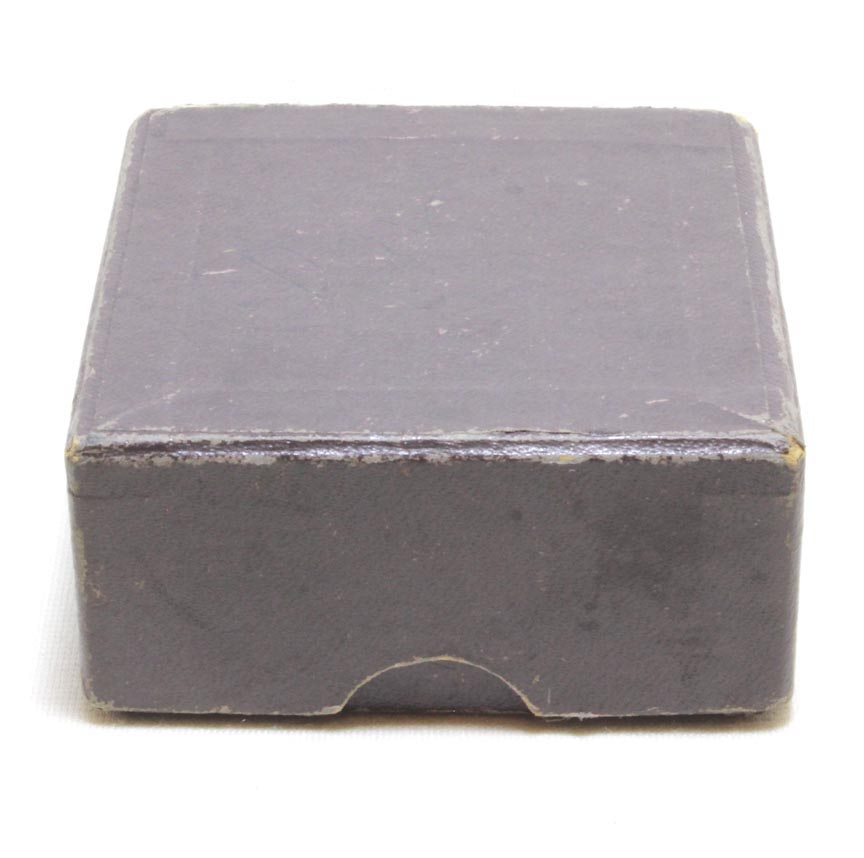
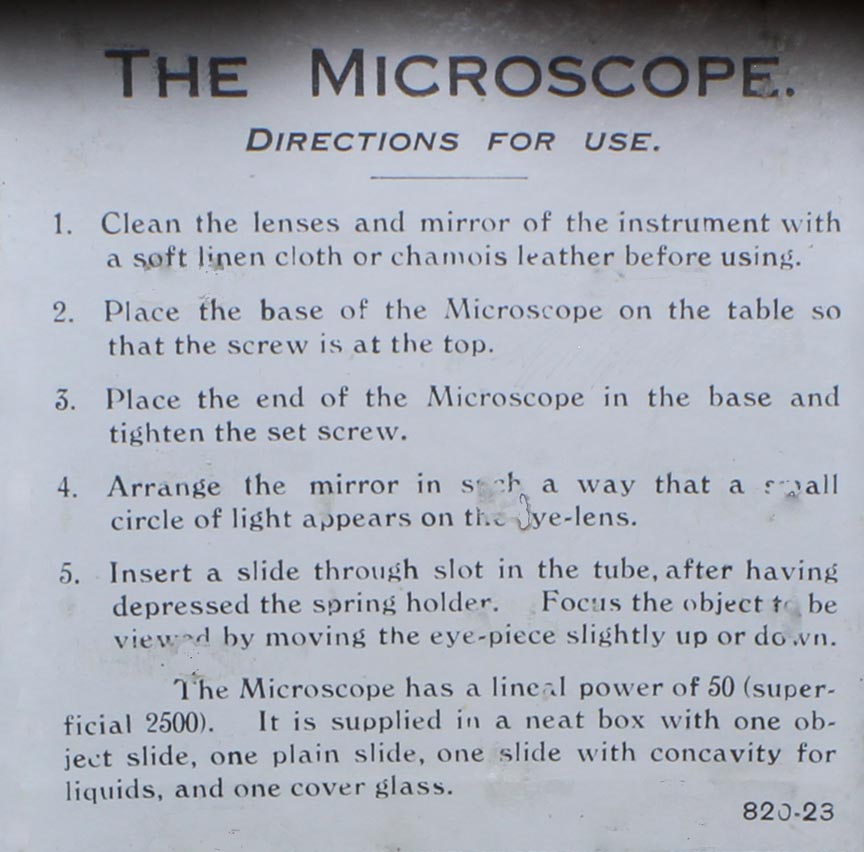 This is just one of many variations of inexpensive pocket microscopes
based on the cylindrical form. It stores in a cardboard case covered in
a dark material. The case measuring about 79 X 82 X 38 mm. The optical
part is made of fairly thin brass with a slot for a slide. Two pins
project outside the microscope, which, when pushed downward, open the slot to allow a slide into the slot. Releasing the pins causes the sprung bottom plate
to press against the bottom of the slide holding it in place. The
optical cylinder measures about 25 mm in diameter and about 50 mm in
height. The single spherical lens is focused by push or pull. The
bottom cylinder housing the mirror is about 48 mm in height and about
28 mm in outer diameter. The brass is relatively thin, but thicker at
the top end to accept the optical cylinder which is held in place by a
knurled knob acting on the end of a set screw. The thick brass
receptacle has a ledge on its bottom, preventing the optical cylinder
from being pushed in too far and also providing extra stability when
the two are attached to each other. The simple flat mirror is rotated
by the knurled knob on the right, while the knob on the left adjusts
the tension on the left mirror pivot-a surprisingly sophisticated feature. When the two parts are combined, the entire instrument has a
height of about 87 mm. There are three small slides. A depression slide
measures 57.5 X 16 X 1.2 mm. The plain slide measures about 62 X 16 X
1.2 mm. The slide with the subject measures about 58 X 15 X 1.2 mm.
Instructions in English are printed on the inside of the cardboard case
which has interior wood fittings for the slides. One small square cover
slip also included.
This is just one of many variations of inexpensive pocket microscopes
based on the cylindrical form. It stores in a cardboard case covered in
a dark material. The case measuring about 79 X 82 X 38 mm. The optical
part is made of fairly thin brass with a slot for a slide. Two pins
project outside the microscope, which, when pushed downward, open the slot to allow a slide into the slot. Releasing the pins causes the sprung bottom plate
to press against the bottom of the slide holding it in place. The
optical cylinder measures about 25 mm in diameter and about 50 mm in
height. The single spherical lens is focused by push or pull. The
bottom cylinder housing the mirror is about 48 mm in height and about
28 mm in outer diameter. The brass is relatively thin, but thicker at
the top end to accept the optical cylinder which is held in place by a
knurled knob acting on the end of a set screw. The thick brass
receptacle has a ledge on its bottom, preventing the optical cylinder
from being pushed in too far and also providing extra stability when
the two are attached to each other. The simple flat mirror is rotated
by the knurled knob on the right, while the knob on the left adjusts
the tension on the left mirror pivot-a surprisingly sophisticated feature. When the two parts are combined, the entire instrument has a
height of about 87 mm. There are three small slides. A depression slide
measures 57.5 X 16 X 1.2 mm. The plain slide measures about 62 X 16 X
1.2 mm. The slide with the subject measures about 58 X 15 X 1.2 mm.
Instructions in English are printed on the inside of the cardboard case
which has interior wood fittings for the slides. One small square cover
slip also included.
HISTORY OF THIS MICROSCOPE
This is but one of many variations of small brass cylinder pocket
microscopes sold from the middle of the nineteenth century through the
middle of the twentieth. Basically this is quite similar to the 'microscope or floroscope,'
but of with a detachable bottom with mirror. Although I have not been
able to date this one exactly, the style of construction and especially
the coarse squared off knurling, suggest this is an instrument from the
first half of the 20th century.
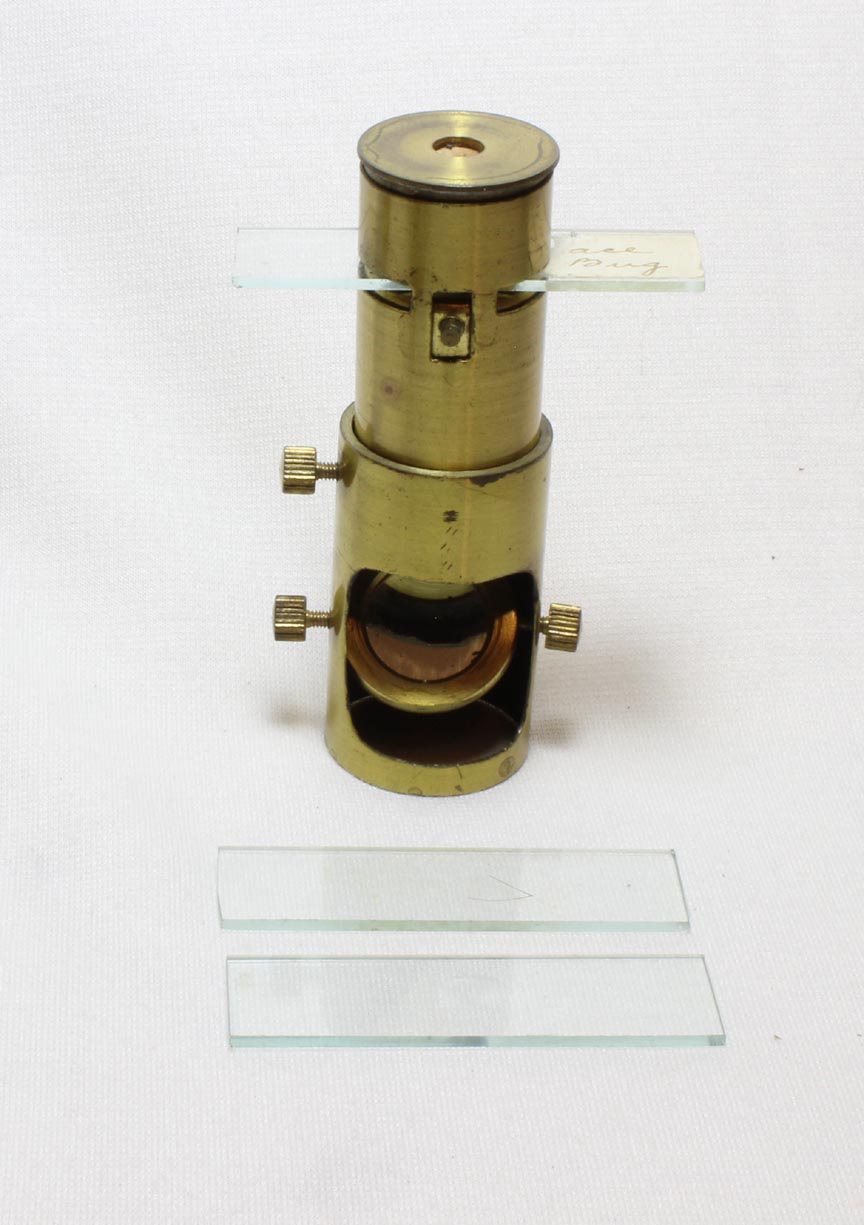
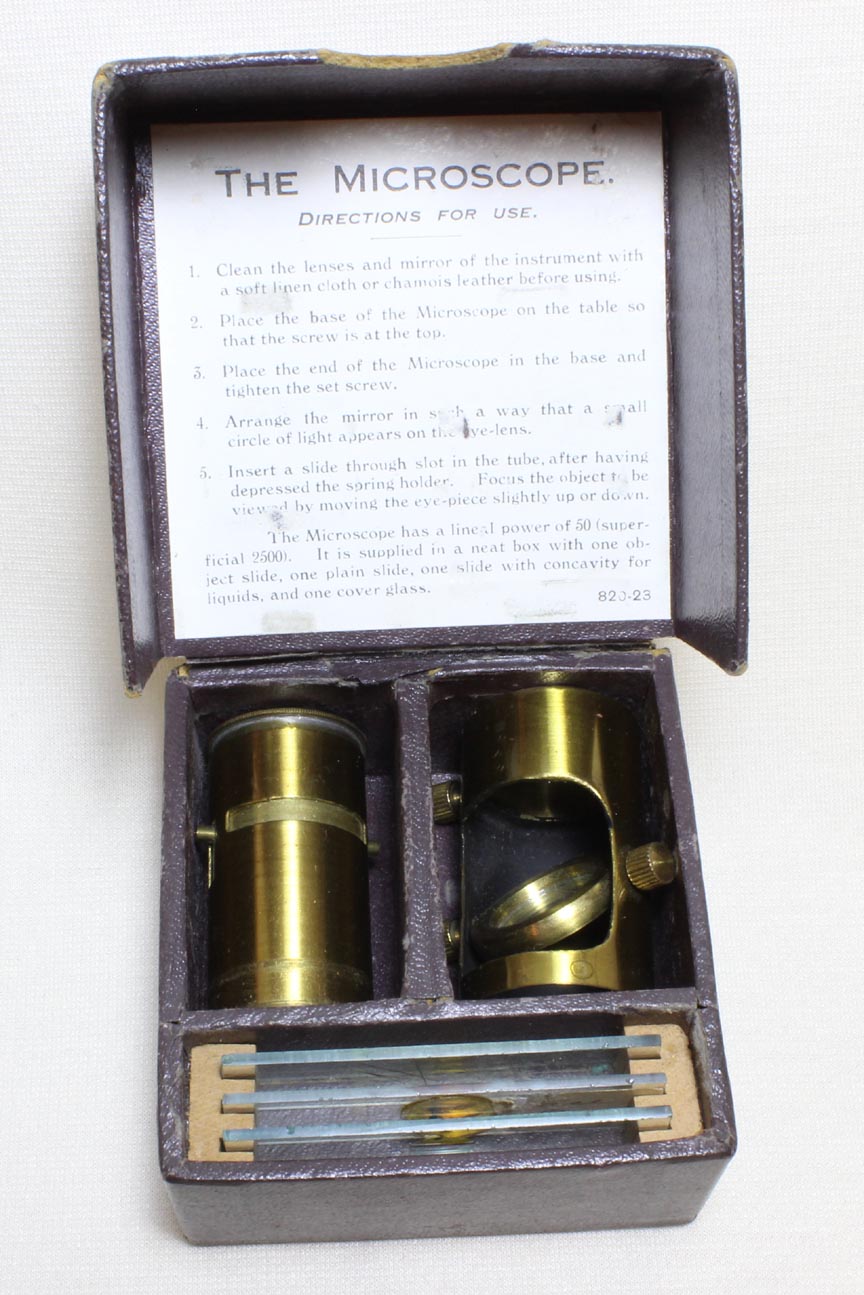
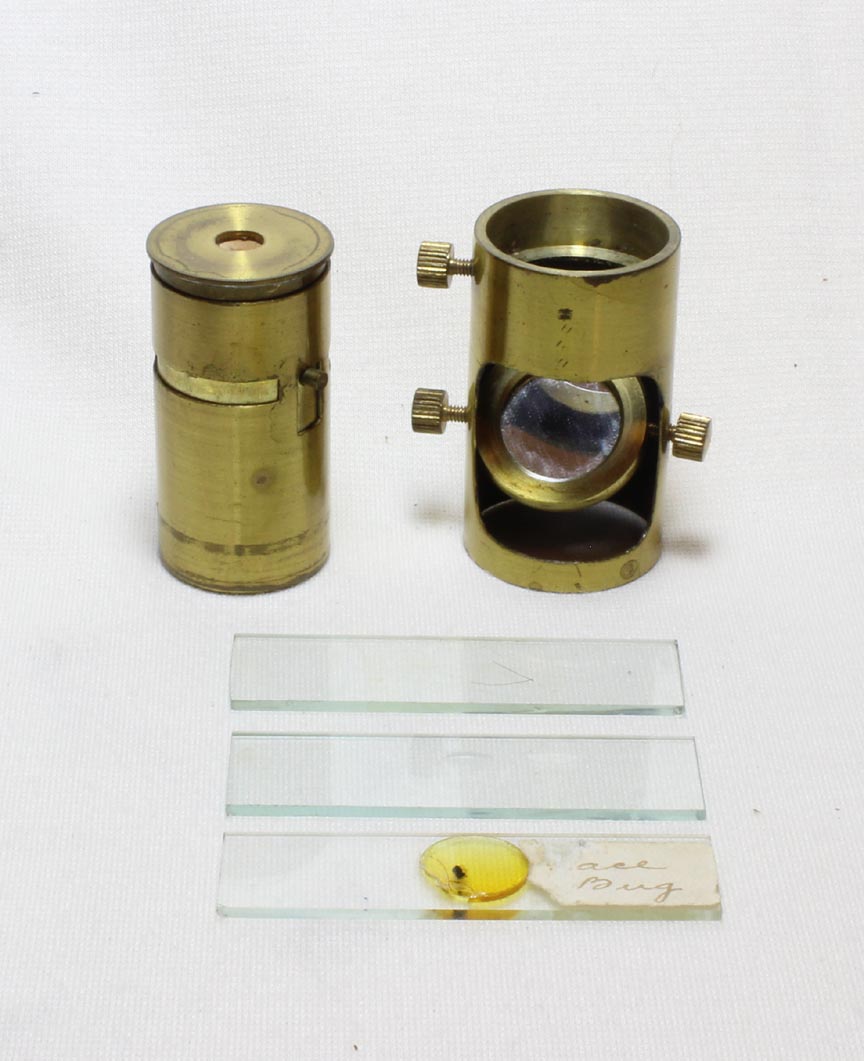

 This is just one of many variations of inexpensive pocket microscopes
based on the cylindrical form. It stores in a cardboard case covered in
a dark material. The case measuring about 79 X 82 X 38 mm. The optical
part is made of fairly thin brass with a slot for a slide. Two pins
project outside the microscope, which, when pushed downward, open the slot to allow a slide into the slot. Releasing the pins causes the sprung bottom plate
to press against the bottom of the slide holding it in place. The
optical cylinder measures about 25 mm in diameter and about 50 mm in
height. The single spherical lens is focused by push or pull. The
bottom cylinder housing the mirror is about 48 mm in height and about
28 mm in outer diameter. The brass is relatively thin, but thicker at
the top end to accept the optical cylinder which is held in place by a
knurled knob acting on the end of a set screw. The thick brass
receptacle has a ledge on its bottom, preventing the optical cylinder
from being pushed in too far and also providing extra stability when
the two are attached to each other. The simple flat mirror is rotated
by the knurled knob on the right, while the knob on the left adjusts
the tension on the left mirror pivot-a surprisingly sophisticated feature. When the two parts are combined, the entire instrument has a
height of about 87 mm. There are three small slides. A depression slide
measures 57.5 X 16 X 1.2 mm. The plain slide measures about 62 X 16 X
1.2 mm. The slide with the subject measures about 58 X 15 X 1.2 mm.
Instructions in English are printed on the inside of the cardboard case
which has interior wood fittings for the slides. One small square cover
slip also included.
This is just one of many variations of inexpensive pocket microscopes
based on the cylindrical form. It stores in a cardboard case covered in
a dark material. The case measuring about 79 X 82 X 38 mm. The optical
part is made of fairly thin brass with a slot for a slide. Two pins
project outside the microscope, which, when pushed downward, open the slot to allow a slide into the slot. Releasing the pins causes the sprung bottom plate
to press against the bottom of the slide holding it in place. The
optical cylinder measures about 25 mm in diameter and about 50 mm in
height. The single spherical lens is focused by push or pull. The
bottom cylinder housing the mirror is about 48 mm in height and about
28 mm in outer diameter. The brass is relatively thin, but thicker at
the top end to accept the optical cylinder which is held in place by a
knurled knob acting on the end of a set screw. The thick brass
receptacle has a ledge on its bottom, preventing the optical cylinder
from being pushed in too far and also providing extra stability when
the two are attached to each other. The simple flat mirror is rotated
by the knurled knob on the right, while the knob on the left adjusts
the tension on the left mirror pivot-a surprisingly sophisticated feature. When the two parts are combined, the entire instrument has a
height of about 87 mm. There are three small slides. A depression slide
measures 57.5 X 16 X 1.2 mm. The plain slide measures about 62 X 16 X
1.2 mm. The slide with the subject measures about 58 X 15 X 1.2 mm.
Instructions in English are printed on the inside of the cardboard case
which has interior wood fittings for the slides. One small square cover
slip also included.